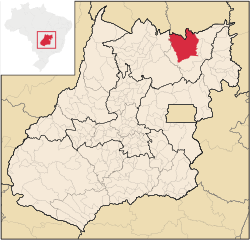Cavalcante
| Cavalcante | |
|---|---|
| Municipality | |

Cachoeira de Santa Bárbara
|
|
 Location in Goiás state |
|
| Location in Brazil | |
| Coordinates: 13°47′40″S 47°27′20″W / 13.79444°S 47.45556°WCoordinates: 13°47′40″S 47°27′20″W / 13.79444°S 47.45556°W | |
| Country |
|
| Region | Central-West Region |
| State | Goiás |
| Microregion | Chapada dos Veadeiros |
| Area | |
| • Total | 6,953.6 km2 (2,684.8 sq mi) |
| Elevation | 823 m (2,700 ft) |
| Population (2007) | |
| • Total | 9,875 |
| • Density | 1.4/km2 (3.7/sq mi) |
| Time zone | BRT/BRST (UTC-3/-2) |
| Postal code | 73790-000 |
Cavalcante is a municipality in northern Goiás state, Brazil. It is one of the poorest municipalities in the state. It is home to communities of descendants of runaway slaves called Kalungas.
It is located just north of the Chapada dos Veadeiros National Park and is connected by tarmacked road with Teresina de Goiás. It is part of the Chapada dos Veadeiros micro-region. The distance to the state capital of Goiânia is 510 km and most residents have greater contact with Brasília than with the state capital. Highway connections from Goiânia are made by BR-153 / Anápolis / Alexânia / BR-060 / Planaltina / GO-430 / GO-118 / BR-010 / São João da Aliança / Alto Paraíso de Goiás / Teresina de Goiás / GO-241.
Neighboring municipalities and states are:
The first settlers arrived in the region in 1736 looking for gold. Soon gold was discovered near the stream called Lava Pés and the village began to grow taking the name of Cavalcante, after Julião Cavalcante its founder. By 1806 the gold had run out and the population declined accordingly. In 1831 the town was elevated to the status of "vila". In 1953 it became a municipality. In 1957 the district of Colinas do Sul broke off to form its own municipality. Likewise, in 1988 the district of Teresina de Goiás was dismembered.
The economy is based on cattle raising (60,777 head in 2006) and agriculture. The main crops cultivated are rice and corn, although in modest production. There was one bank—Banco do Brasil S.A. (Agosto/2007)
Agricultural data 2006
Founded in 1740 with the discovery of gold, Cavalcante still has traces of the colonial architecture of the gold period. Located 330 km. from Brasília it has waterfalls, streams and trails. Crossing the low mountains one can reach the springs of hot mineral water that gave the name to a now extinct mining town—Água Quente.
...
Wikipedia

